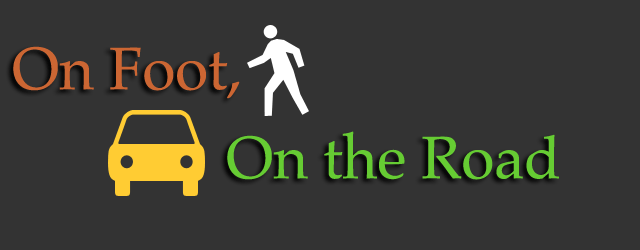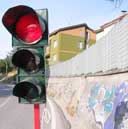
Story by:
James DaSilva
Web design: Kimberley Coughlin
Video:
Katherine Swartz
Photography: Matt Satterfield

Stepping Out Into The Darkness
Every night students in Cagli walk home late. The air has cooled, it is fairly quiet, and the
thought of getting some sleep usually brings a smile. There are sidewalks to safely stride
upon, or at least cobblestoned roads to slow down reckless motorists.

But after I cross the bridge into New Cagli the sidewalk disappears. The road curves sharply, and visibility is obscured, if not completely cut off, by the hardly working construction crew. This road, as well-traveled as any in town, is known by all in the Cagli Project who wish to check e-mail at the local computer store, as well as 6 program members who live beyond the bridge. Students forced to walk along the edge of the road pray for the best. A car cuts the corner, or perhaps a truck or commercial vehicle too wide for the road, or a car takes the turn too fast. All these scenarios could hold tragic consequences.

Yet, so far, nothing tragic has taken place. Why not? Luck probably plays a part, yet people here usually drive impeccably-- the driverŐs manual ideal of driving seldom practiced in real life. Drivers stay within the lines like that talented five-year old at coloring time, and drivers brake around each turn, especially those in which the view ahead is limited. If it isn't cool to be a rule-following motor vehicle operator, why do the Cagliese choose this driving style?

The secret may lie in a knowledge of the area. Cagli's drivers seem to possess an innate awareness of what might lie beyond the next hill or around the next bend. Furthermore, they act as if we are all pedestrians, even if our mode of transport is something other than our feet. Cagli: Confident yet deliberate and considerate driving. Not a sexy slogan, but one for which our own hometowns could undoubtedly strive.

But Those Italians Can't Drive, Can They?
Italians hold a reputation for being reckless in their driving, one more often earned in big
cities such as Rome rather than in small outposts like Cagli. Running in town has brought me
more prolonged exposure to the town's fast-moving traffic than your average American visitor.
There often isn't a whole lot of traffic here in town. Some roads I'll run several different
days, at varying times, without ever seeing another vehicle, encountering only cats, dogs, and
chickens, not necessarily in that order.

Granted, not every road is undisturbed. The street I live on connects to a busy thruway, which brings the usual assortment of Fiats, Opels, Apes, and mopeds that would fit in the trunks of American SUVs. But what most often wakes us up in the morning are the construction vehicles, the supply trucks, and the street sweepers that frequent this expanse. This road, of course, is one of the many without sidewalks for a long stretch, necessitating a daring venture to the edges of the street.

Such adventures bring their own perils. Occasionally, as I stroll towards the Atrium for class, a Cagli bus or industrial vehicle will pass at about 50 kilometers per hour, coming within a meter of obliterating me, as happened today on the walk to the lab to type these very words. At such a close distance, you are hit without getting hit. The aftermath of the vehicle's near-assault is a warning, a blast of wind that strikes just as you think things are safe.

Despite the moments of alarm along the highway, only competent, controlled driving could have avoided an accident with such ease. Back home, or even in a larger Italian city, the driver might have reached 65 kilometers per hour, tried to cut the turn, or maybe not even have seen me. Outside of Cagli, I have to watch for the drivers. Here, all I have to do is watch myself so that I won't needlessly get in their way. Paradoxically, this is the greater challenge. In Cagli, the traffic is so sparse, the drivers generally so competent, that it is easy to become careless. Not that I'm complaining. I'll be missing Cagli driving the next time I have to face those crazy American drivers and their no-holds barred aggression.

VIP Traffic and Cobblestone Musings
The roads of Cagli, though lightly traveled, have seen many types of passengers. In our short
time here, the town has encountered several unusual sights. On the anniversary of the Republic,
a day celebrating democracy's inception in Italy, military vehicles squeezed through the alleys
to dominate the piazza with their green bulk. One looked like an olive-hued box, topped by a
formidable gun and the capacity for several soldiers. It settled in next to the sky-blue
motorcycles of the polizia and navy trucks of the carabinieri. I saw some polizia writing
tickets in an attempt to discourage illegal parking.

Throughout the next week, numerous billboards that depicted frightening Italian clowns advertised the circus. Also used in this promotion was a small truck that, each day, rattled around the narrow streets, its megaphone shattering the quiet evening air. There could be no doubt about as to the imminent arrival of the circus.

When the day finally came, the drama began in the afternoon as the several elephants marched through the piazza in single file. Each locked its trunk with the tail of the elephant ahead of it as handlers anxiously guided them along. The animals proved the only force capable of clearing the cobblestoned street, a fact on which this confirmed pedestrian reflected in fascination.

The cobblestones recall an earlier time, when animals were the main mode of transport, the engine's whine was the horse's whinny, and, instead of the squeal of brakes, one heard the clack-clack of hoofs and path. To the casual observer, the makeup of the roads is one of the few obvious differences between New and Old Cagli. New Cagli is paved by modern roads rushing over the hilly terrain, and they attract more aggressive driving. Old Cagli is steeped in tradition, and crisscrossed by older, narrower, bumpier roads. Cobblestones possess an elegance that belies their lesser ease of use. The roads of Old Cagli reflect the pace of life and sense of history of their location. While New Cagli may not be cutting edge, it still seems ready to march forward. Together, new and old, paved and cobblestoned, two Caglis coexist, connected by their ruminative and rich place in history and the future.

Fringe Benefits
Beyond the traffic, the roads in Cagli are exceptionally clean. Without the placement of
large "No Littering" signs or an abundance of public trash cans, the Cagliese have managed
to keep garbage off their roads. No Adopt-A-Highway Program is necessary here in Cagli, as
city beautification is seen as a responsibility, not a voluntary activity.

A clean road system has manifestations far beyond, well, roads being clean. Water and air pollution is reduced. Aesthetically, clean roads allow Cagli's rolling valleys and hills, the scattered vineyards and the two rushing rivers, to take center stage. The roads then blend into the landscape as if they are part of the earth. The roads of Cagli are pathways to nature and to people who prefer to live far from human commerce and environmental pillaging.

Better yet, roads without garbage minimize the discordant
symphony of flies that normally
accompany the American summer. Perhaps for the first time, American visitors can sit inside
with the doors and windows open and view the dawn and dusk beyond gently shimmering curtains
rather than fly-spackled screens.
All this because of clean roads. The might of the 21st century is often helpless against
pollution. But in Cagli, a town which reaches back to the first of those centuries, has
always had the upper hand.

On The Road Of Life...
All this reflection comes when the roads of Cagli are free of American drivers. What would
we say if we,too, sat behind the wheel, rattling our own cars over the cobblestones.
Surprisingly, we may be better able to reflect than drivers. The open road has always been
about travelers. Being a pedestrian is to be one with the road, yet moving slowly enough to
have perceptions, both conscious and intuitive. The pedestrian has a greater range of view
than the driver, who must focus on the task at hand. For the driver, the road is a rolling
video, each moment new, yet fleeting. For the pedestrian, the road is a canvas that never has
to be completed.

